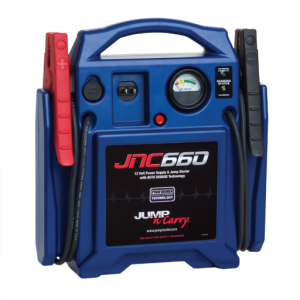There are several steps that will keep your jump starter in good operating condition and support a long service life. Keeping these steps in mind could extend the life of your jump starter as much as two to three times longer than if you do not follow these basic recommendations. Of course, that is the key: you must follow these steps if you want to get the best and longest service from your jump starter.
1. Keep your jump starter charged. Avoid letting the unit sit in a highly discharged state. Remember, jump-starter batteries have no memory issues. You cannot harm them with frequent charges, even when they are only slightly discharged. So, plug in your jump starter early and often. The best practice is to charge a jump starter after each use. Even in those cases where this type of charge frequency is unrealistic, nightly charging should be done if the unit is used often. If you do not use the jump starter regularly, make sure to charge it at least every three months to ensure the battery is not sitting in a discharged state for extended periods.
2. Respect the duty cycle of your jump starter. Every jump starter is subject to a
3. Whenever possible, store your jump starter in a moderate temperature, between 50˚F and 70˚F (10˚to 20˚C). As with vehicle batteries, exposure to extreme temperatures is detrimental to jump starter batteries in the short and long term. Besides extending your jump starter’s life, keeping it in the right temperature range can give it more oomph. For instance, a jump starter stored at 20˚F will have less jump-starting power for a needed jump start than one stored at 60˚F. In the long term, extended exposure to high storage temperatures (> 90˚F) will reduce the service life of a jump starter battery.
4. When you have completed a successful jump start, it is important to disconnect the jump starter from the now running vehicle as quickly as possible. Always remember to follow all safety procedures and the proper disconnection sequence when you are taking the cables off. Typical vehicle alternator output is much higher than the recommended recharge rate for a jump starter battery. Charging any battery at a rate greater than the recommended charge rate is detrimental to its long-term health. Many technicians leave the jump starter connected after a successful start, thinking that it is a fast and easy way to get the unit recharged. You should avoid this practice. It will do more harm than good. Charge your jump starter in the normal way to support a long unit life.
5. Until now, our focus has been on the battery, which is the heart of a jump starter and the most critical component impacting its durability and service life. To get the most out of your jump starter, you should keep other factors in mind too. Remember that many batteries the jump starter comes into contact with are in poor condition, which can result in battery acid on or around the posts. After jumping a vehicle with a battery in such a condition, wipe down your jump starter’s clamps (particularly the positive, which is the only clamp that should contact the battery) with a clean cloth to remove any residual battery acid. For clamps that have a high level of acid contact, use a mixture of baking soda and water and a wire brush to thoroughly clean them.
Following these simple steps can greatly extend the life of your jump starter. In addition, taking care of your jump starter will also help ensure it is ready for service each time you need it so it will provide the peak power you need to get engines going again.






42 Responses
Good Morning, I just had a simple question. I have the exact jumper as the picture, can this jumper be stored lying down? Or is it not a good idea?
Moises – Thanks for your question. Our lead acid jump starters are manufactured using sealed, non-spillable AGM batteries and can be stored in any position or orientation. The same is also true for our lithium battery jump starters. Thanks, Jim from Clore Automotive
Lithium battery does not like to be in 90% or more charged state, it degrades the cathodes. The best way to extend the life is to make it close to 40-60% in the entire life.
John – Thanks for your comment. The difficulty lies in the fact that it is a jump starter battery, so you’ll want it charged higher for effective jump starting. As you point out, though, with lithium it is more of a balancing act than with lead acid batteries. Thanks again, Jim from Clore Automotive
Not true. False information.
Hey there, is it possible to overcharge lead acid jump starters? I often remember to charge it but I forget to disconnect for a week.
It slows to a trickle charge so it’s ok to leave it plugged
George – Thanks fro your question. All of our jump starter models have automatic charging operation with overcharge prrotection, so yes, you can leave them connected to AC indefinitely without adverse effect. Thanks, Jim from Clore Automotive
If you leave your lithium ion jump starter battery in the car will excessive heat just decrease the batteries lifespan or is there some real danger?
Dana – Thanks for your question. Excessive heat isn’t great for any jump starter, whether lead acid or lithium. Normal temps shouldn’t be an issue for safety. With lithium, it could be dangerous if the heat got very, very high. We suggest not storing them in a small, enclosed space such as a glove box, which can get extremely hot, much hotter than the vehicle’s interior. It would bettter under a seat and it is always best to crack a window to prevent excessive heat build-up inside the vehicle just as a general practice. Thanks, Jim from Clore Automotive
Can this jumpstarter bebusedcto completely charge an agm battery? If so how long do I leav it connected.
If not, what piec or portable equipment do I need?
Hope – Thanks for your question. Our jump starters are great for overcoming a dead starting battery of all kinds, including standard flooded, AGM, Gel Cell and even lithium starting batteries. That said, a jump starter is not a charger. If you want to service your AGM battery to preveent it from draining down and going dead in the first place, we would recommend purchasing a battery maintainer such as our PL2140 model (https://cloreautomotive.com/product/pl2140/). To bring a battery to full charge, effectively and beneficially, this is what is needed. Plus, the PL2140 has a specific setting for AGM batteries, which we would say is critical in giving your battery the service it needs. Thanks again, Jim from Clore Automotive
My question is about the battery dying too soon. I take mine fishing at night for light. I bought 1 year ago and it wont hold a charge anymore. It used to last for hours. Now I might get 30-40 minutes. What is the exchange or warranty process on these units?
Bruce – We are sorry that you are have an issue. I suggest that you call our Tech line at [800] 328 2921, option 2. They should be able to help diagnose the issue. The unit comes with a one-year limited warranty against defects in materials and workmanship. Thanks, Jim from CLore Automotive
I bought a jump starter for both of my daughters for this Christmas haven’t given them yet want to make sure they know all the ins and outs before I give it to them I don’t want their jump starter to get too cold where it is useless then on the other hand they need to have it with him in case they need it
Delton – Keeping your unit fully charged is the most important thing for overcoming the cold. If you are expecting extrememly cold overnight temperatures (<-10˚F), it might make sense to bring the unit inside overnight, depending on the size and reliability of the jump starter itself. For instance, a fully charge JNC660 can sit overnight at <-20˚F temperatures and still be used to start a vehicle in thee morning, but other units in the market likely would not be useable in such an instance. So, it does vary. I hope this is helpful. Jim from Clore Automotive
We bought a TruckPac ES 1224 Series 3000 in 2018-07 and the internal batteries are shot. What is the expected life cycle of batteries under good conditions? Also, we keep the unit plugged into an electrical system that come through a Magnum MS Series Pure Sine Wave Inverter/ Charger MS4024. This is a heavy duty inverter that has not caused issued with any other devices.
Rick – Thanks for your question. Many factors can influence the life of a jump starter, but they typically last 2-3 years in a professional environment where they are used regularly. It is not uncommon to get a longer life (or a shorter one), depending on frequency of charge, the demands of the vehicles the unit is used to start, weather conditions (extended very high heat depletes batteries), etc. So, it is not an exact science, but that is the typical lifespan. I suspect that your inverter did not cause damage to the unit, it being a pure sine wave unit. Thanks again, Jim from Clore Automotive
I have a m a 1000 matson can I re charge at 75% to full through my phone charger lead?
Gerald – Are you referring to a 1000mA wall charger? If so, what jump starter model are you trying to charge? Thanks, Jim from Clore Automotive
Can you connect a jump starter directly to a starter
Bill – Thanks for your queastion. Yes, you can do so. You can connect the positive jump starter lead to the battery positive connection point on the starter and ground the negative jump starter lead to a good chassis or engiine ground (as you normally would). All of the usual steps should be taken for safety, especially ensuring that the jump starter leads are not positioned in the path of any moving engine components, such as fans, etc.Thanks, Jim from Clore Automotive
I have only used my 600A jump starter once and left the switch on, although disconnected. How do I k iw when it’s fully charged and can I charge it overnight.. Thank you.
Juanita – Thanks for your question. I am not sure which jump starter model you have, but leaving the switch on (but not connected) shouldn’t run your unit down. Whatever model you have should provide some method for checking its state of charge. I suggest turning the switch off, charging the unit overnight and then checking the state of charge (is it fully charged?). Thanks, Jim from Clore Automotive
My jump starter has sat uncharged for 2 years can it be charged? or do I need to a new one?
Joe – Thanks for your question. The answer is, it depends. The best bet is to try to charge it. If it immediately goes to full charge, the battery is likely sulfated beyond the point of no return. If the unit takes 10-24 hours to charge, I would suggest disconnecting it once it reaches full charge, letting it sit for 2 days and then checking the unit’s status. If it is totally dead after 2 days of sitting, it is (again) likely sulfated. If it is not totally dead, I would suggest charging it again. By doing this process 3-4 tiimes, you may be able to recover the battery. Thanks, Jim from Clore Automotive
I’m not sure on the model but mine has the air compressor feature w the curly hose…I leave it plugged in & stored in the basement…it has never let me down in the almost 10 years I’ve had it…The power isn’t what it was new but pretty good & the compressor just stopped working out of the blue…can the battery be replaced in these & any idea why the compressor would stop working? Love the thing, Thanks
Bondy – Thanks for your comment and question. Sounds like you have the JNCAIR. Yes, the battery can be replaced (JNC105), as can the compressor. It is difficult to troubleshoot the unit here. I suggest calling our Tech line at [800] 328 2921, option 2. They will be able to help diagnose the issue. Thanks again, Jim from Clore Automotive
I have the Stanley Jumpit 1000 and I keep it plugged in all of the time so that it’s fully charged if I should need it. Is it OK to do this?
Gary – We do not manufacture Stanley branded products, so it is difficult to know the correct answer, as it relates to the Jumpit 1000. We did, at one time, manufacture a unit for Stanley PROTO, the JFE5120. I suspect that is not the unit you are referring to. But, in case it is, please see the unit’s bottom label. If it has an icon on it with the letters BC in a circle, yes, it’s OK. If it is a very old unit and does not have this icon, no, care must be taken not to overcharge it. We suggest connecting it to the charger at night and taking it off the charger the following morning. Thanks, Jim from Clore Automotive
JNC77DR – 12V jump starter. Can I store and charge my unit in my home? Does the unit off gas…..ever? Never knew how much I needed one. My father bought as a Christmas gift….awesome gift. He has two…. Thank you in advance.
Eddie – Thanks for your question. We are glad it is serving you well. For sure, you can charge it in your home. It will not gas under standard charging conditions (connecting an extension cord to the built-in charger). Thanks again, Jim from Clore Automotive
I have the Carlyle 325 jump starter. I know the charging method is to use the ac cord but no mention is made about the double male end cigarette lighter cord except keeping settings while changing a battery. Coming through the small wire cigarette plug, would that be too much current to use to recharge the battery?
Ricky – Thanks for your question. Correct, we did not cover using the Male-Male cord for charging. This charging method is often misused and we chose not to cover it in the manual to try to avoid some of that misuse. Yes, the Male-Male cord can be used to turn the CJS12V325A into a memory saver, but there is a caveat. The vehicle being serviced must have a live power port when turned OFF. Most modern vehicles disable the power port when the vehicle is completely turned off. The best option is to use our Memory Saver Connector, ESA30, which connects the jump starter to the vehicle’s OBDII port, which is always live. I hope this helps. Thanks again, Jim from Clore Automotive
I have the same question. I’m interested in using the male -to-male cable to recharge the battery pack after using and (on occasion) maintain/slow charge the car battery over night. Neither seem to work for me even though my 12v outlets remain live with key off
Nick – Thanks for your question. If your 12V vehicle outlet is powered while the vehicle is turned off, I am not sure why you’re not getting a charge from the vehicle’s battery. Please keep in mind that using the Male-Male cord while the vehicle is turned off (even if the 12V outlet is powered) will be a very slow process, as the vehicle’s battery (with a high state of charge) passes some of its power to the jump starter. Charging via this method can take hours. Thanks, Jim from Clore Automotive
Is it possible to bypass the battery and use direct current from a 110 outlet for just the compressor to stay functional
Jerod – Thanks for your question. No, this is not possible. The compressors in our units are 12V powered and designed to be run off the internal battery. Thanks again, Jim from Clore Automotive
Wether I can get spare battery. If so where I can buy it.
Further wether jump starter can be used for charging mobile phone regularly
R Nataraj – Yes, replacement batteries are available for our lead acid units. Please advise which unit you have? Batteries can be purchased through our site (Jump Starters > Jump Starter Accessories). Yes, the units can easily charge a cell phone, but in some cases require a USB adapter. Thanks, Jim from Clore Automotive
my wife is insisting that I keep my jump starter in the garage.
2 questions:
a. can I leave the jump start plugged in and recharging overnight? I know on airplanes they are always worried about lithium batteries spontaneously igniting , is that a worry here?
b. my garage doesn’t get really hot in the summer but it can go below freezing in the winter. is that a big worry too?
c. I have a 199 Nissan pickup. I drive it about 5 -10 miles per weekend. I heard somewhere that to disconnect the negative terminal can actually save battery life. any truth to that? I’m willing to try even though it would seem like a miserable pain in the butt.
thank you. I love my jump starter.
Siward – Thanks for your questions. If you purchased your jump starter from us (not sure which model you own) in the last 4-5 years, you can keep it connected to the charger indefinitely with no adverse consequences. Not a huge concern about the cold garage. We’d recommend charging your unit right before a deep cold snap, since a fully charged unit fares better in the cold than a discharged unit. Yes, many advocate for disconnecting the battery and it can be helpful, but as you state, it is inconvenient. Honestly, we’d only recommend doing so if your vehicle went weeks/months without use. Honestly, your better option is to get a quality battery maintainer (such as our PL2112 or PL2140) and connect it when your vehicle is inactive for any significant period of time. Thanks, Jim from Clore Automotive